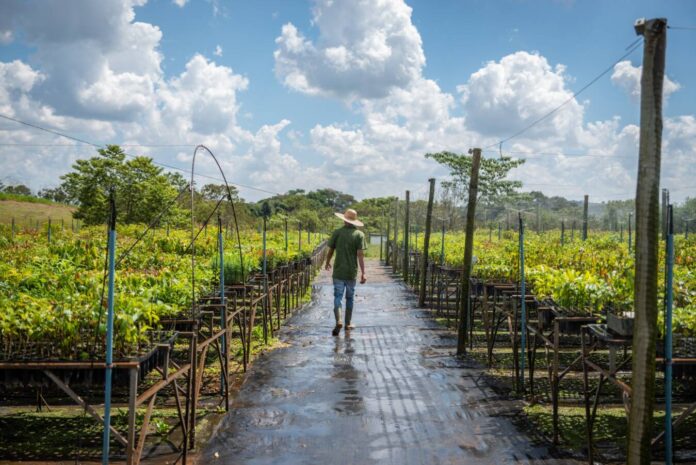The Paranaense rainforest, once a verdant expanse teeming with unique species, has suffered catastrophic losses, with over 90% of its original cover vanished due to logging, agriculture, and infrastructure [G6]. Launched in recent years, the PRFSP seeks “functional restoration” through reforestation, ecosystem connectivity, and sustainable practices, involving governments, NGOs, and international partners [Planet Keeper Executive Summary]. Recent milestones, such as planting 100,000 trees in Argentina’s Misiones province, highlight collaborative efforts with groups like the Instituto Misionero de Biodiversidad and Aves Argentinas [Web:0, Web:3]. However, amid rising deforestation rates—3.7 million hectares lost in tropics in 2023 [G13]—critics argue the plan overlooks root causes like soy monocultures, potentially perpetuating a cycle of “restoration debt” [Planet Keeper Insight 1]. This overview synthesizes factual data from sources like the World Bank and social media trends to assess the plan’s true impact.
Achievements and Ecological Impacts
The PRFSP has delivered tangible progress in reforestation, aligning with broader South American initiatives. In Misiones, Argentina, 10,000 native trees were planted in Puerto Rico as part of the plan, led by experts like Violeta Álvarez and José Beamonte Reta. Similar efforts in Puerto Libertad added another 10,000, contributing to a goal of 100,000 trees by year-end [5]. These actions support biodiversity recovery, potentially reviving 293 plant species and 172 bird species, as seen in comparable Brazilian projects [G10].
Drawing from parallel programs, the World Bank’s Amazonas project allocates $592.5 million for fiscal sustainability and forest conservation, echoing PRFSP’s habitat goals [2]. BNDES has released $15 million for Amazon and Atlantic Forest reforestation via the Climate Fund [1].

Social media posts celebrate these milestones, with users sharing stories of community plantings and species resurgence, such as jaguar repopulation in reserves [Web:3; Planet Keeper 2]. Experts note that such efforts enhance carbon sequestration and mitigate climate change, with UN recognition for Atlantic Forest restoration under the Decade on Ecosystem Restoration [7].
Criticisms: Greenwashing and Exploitation Concerns
Despite successes, the PRFSP faces accusations of masking exploitation. Analyses suggest it enables agribusiness expansion, with funding from bodies like the World Bank prioritizing carbon credits over local needs [3]. In Paraguay, reports highlight deforestation linked to eucalyptus plantations, potentially undermining biodiversity [4]. A ScienceDirect study warns of ongoing habitat fragmentation from soy and cattle ranching [G6], while Mongabay reports tropical losses equivalent to Panama’s size in 2023, casting doubt on zero-deforestation targets [G13].
on social media, critical threads from users like SOS Mata Atlântica decry legislative threats to biomes, labeling restoration as greenwashing for corporate gains [G20] [2]. Indigenous displacement is a flashpoint; Earth.Org notes how projects can lead to “land grabs” without consent [G12], echoing Planet Keeper’s insight that viewing land as a carbon sink ignores cultural heritage [2]. In Brazil, the Bioeconomy Finance Coalition aims for $10 billion by 2030, but critics argue it subsidizes monocultures [5] [G7]. These viewpoints reveal a “narrative divide,” where official optimism contrasts grassroots skepticism.
Funding, International Ties, and Emerging Trends
International support bolsters the PRFSP but invites scrutiny. The Tropical Forest Forever Facility (TFFF), hosted by the World Bank, proposes $25 billion from donors and $100 billion from private capital for global conservation [3]. Brazil hails this for COP30 goals, including 12 million hectares restored by 2030 [G18]. Yet, experts question if such funds perpetuate exploitation, as seen in Paraguay’s “sustainable” forestry managed by firms like Paracel, accused of prioritizing profits [2].
Trends point to community-led models as alternatives. Indigenous restoration in Ecuador offers deforestation-free blueprints [G4], while degrowth advocates push for reduced consumption over growth-oriented bioeconomies [4]. Social media discussions amplify calls for transparency in carbon schemes, with FAO Paraguay posts emphasizing anti-crime integrations for forest protection [2]. The UN’s special award for Atlantic Forest efforts underscores potential for inclusive strategies [7].

Constructive Perspectives and Solutions
Balanced views emphasize solutions. Proponents like NRDC advocate addressing deforestation drivers through policy reforms and sustainable agriculture [G1]. Planet Keeper suggests integrating degrowth by scaling down agribusiness and empowering locals, fostering resilient economies [Planet Keeper Insight 3]. Active initiatives include World Bank projects respecting indigenous rights [G14] [6], and Brazil’s coalition mobilizing funds for bioeconomy innovation [5].
Concrete steps under study: Enhancing REDD+ programs for equitable carbon benefits [G2], modeling after successful reforestations like Sebastião Salgado’s 2.7 million trees in Brazil. Community involvement, as in Misiones’ jaguar and howler monkey projects [3], could bridge gaps. Experts recommend monitoring biodiversity metrics against claims to ensure genuine revival.
Given the current search results, there is no specific information available about the Plan de Restauración Funcional de la Selva Paranaense. However, I can provide relevant information on similar initiatives and trends in forest restoration and conservation in South America.
KEY FIGURES:
- BNDES Funding: Approximately $15 million for reforestation in the Amazon and Atlantic Forest through the Climate Fund[1].
- World Bank Operation in Amazonas: $592.5 million for fiscal sustainability and forest conservation[2].
- Tropical Forest Forever Facility (TFFF): Proposed initial investment of $25 billion from donor countries and $100 billion from private capital[8].

RECENT NEWS:
- World Bank TFFF Initiative: The World Bank is confirmed as the trustee and interim host of the TFFF, aiming to secure and sustain tropical forests globally[3].
- Brazil Restoration & Bioeconomy Finance Coalition: Launched to mobilize $10 billion for forest conservation and bioeconomy by 2030[5].
- AM Pro-Sustainability Project: Focuses on enhancing fiscal sustainability and forest conservation in the State of Amazonas[2].
STUDIES AND REPORTS:
- Paraguay Forestry Report: Highlights concerns about deforestation and biodiversity loss linked to eucalyptus plantations[4].
- UN Decade on Ecosystem Restoration: Recognizes efforts to restore South America’s Atlantic Forest as part of global restoration initiatives[7].
TECHNOLOGICAL DEVELOPMENTS:
- There are no specific technological developments mentioned in the search results related to the Plan de Restauración Funcional de la Selva Paranaense.
MAIN SOURCES:
-
- BNDES Climate Fund: https://greenfinancelac.org/resources/news/bndes-releases-resources-from-the-climate-fund-to-reforest-areas-in-the-amazon-and-the-atlantic-forest– BNDES funding for reforestation.
- World Bank Amazonas Project: https://www.worldbank.org/en/news/press-release/2025/08/28/new-world-bank-operation-links-fiscal-sustainability-and-forest-conservation-in-amazonas – AM Pro-Sustainability project details.
- Tropical Forest Forever Facility: https://www.cop30.br/en/news-about-cop30/the-world-bank-confirmed-as-trustee-and-interim-host-of-the-tropical-forest-forever-facility – TFFF’s role in forest conservation.
- Paraguay Forestry Report: https://environmentalpaper.org/wp-content/uploads/2025/02/Paraguay-Forestry-report.pdf – Environmental concerns in Paraguay.
- BRB Finance Coalition: https://www.nature.org/en-us/newsroom/brb-finance-coalition-launches-10-billion-for-forest-conservation-and-bioeconomy-2030– Brazil’s restoration and bioeconomy initiatives.
- World Bank Projects in Amazonia: https://www.worldbank.org/en/programs/supporting-amazonia/projects – Overview of World Bank projects in the Amazon region.
- UN Decade on Ecosystem Restoration: https://www.decadeonrestoration.org/stories/un-recognizes-effort-restore-south-americas-atlantic-forest-special-award – Recognition of Atlantic Forest restoration efforts.
- Brazil Hails TFFF Decision: https://www.climatechangenews.com/2025/10/22/brazil-hails-world-bank-decision-to-host-forest-fund-ahead-of-cop30-launch/ – Brazil’s support for the TFFF initiative.


